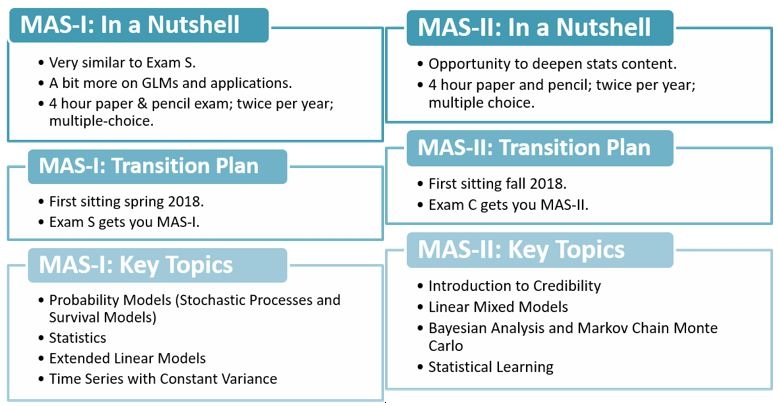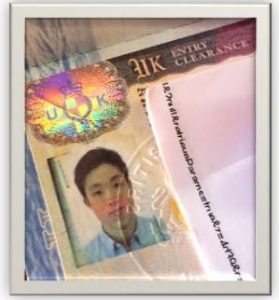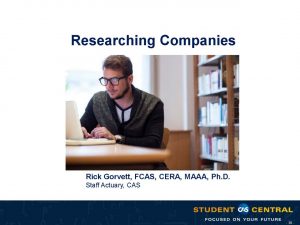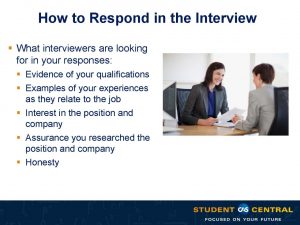
CAS Basic Education Update, Study Tips and Techniques Webinar Recap!
CAS Student Central hosted a webinar last month to provide you with actuarial exam study tips and techniques, and to update you on recent changes to CAS credentialing requirements. The webinar was presented by Ken Fikes, FCAS, Director at The Infinite Actuary, and Rick Gorvett, FCAS, CAS Staff Actuary.
Didn’t get the chance to catch it? Not to worry! You can watch the live recording through the Student Central online community. Additionally, this blog post provides a recap of the information that was covered.
Let’s start with the exam updates.
Last January the CAS announced the creation of two new exams being offered in 2018, Modern Actuarial Statistics I and II (MAS-I and MAS-II). On the webinar Rick Gorvett discussed how these exams address the emerging needs of future actuaries and their employers, and provided information on the format, transition plan, and key topics for each new exam. He also walked through the transition rules and commonality with the SOA’s exam requirements.

Moving along to study resources and tips!
Ken Fikes from The Infinite Actuary covered a number of topics, applying concepts from Stephen Covey’s “The Seven Habits of Highly Effective People,” to help you successfully study for actuarial exams. Outlined below are a few key tips and techniques he shared during the webinar. We encourage you to view the recording to access the full list of recommendations.
Practice Problems
Aim to finish learning the actuarial exam material 4-6 weeks prior to your exam date so you have adequate time to practice problems. Learn to understand what each problem is asking and apply your knowledge to get the correct answer.
Speed Matters
When taking the preliminary actuarial exams, you will have about six minutes to solve each problem. As you are working through problems, keep a list of those that you missed and those that took you significantly longer than six minutes to complete.
Practice Taking the Exam Two to Three Weeks Before Your Scheduled Exam Date
This will serve two main purposes:
- To prepare your mind and body for what you will experience on exam day. For example, use a timer, don’t take breaks, take the exam at the end of a long day when you are tired. Familiarize yourself with the stress and fatigue you might encounter during the real exam.
- To test what you know and how fast you can work the problems! Once you’ve identified your strengths and weaknesses, you can focus on specific areas to improve your results. Don’t waste your time taking exam after exam without understanding what you missed.As members of CAS Student Central, you have access to free practice exams for P and FM made available by The Infinite Actuary! Take advantage of this resource available to you.

Where to Study
Pick a place where you can focus and not get distracted. Turn off your phone. Avoid wasting extra time preparing for the exam because of interruptions.
Tailor your study activity to your surroundings. Watch a video lesson or listen to a recording during your commute. Review flashcards during lunch or while walking.
When to Study
Determine when you study most effectively. It may work well for some people to study early in the morning and during their lunch breaks, while others may find it more effective to study after work or on the weekends. Once you figure out the timing that works best for you, make this study time a priority and stick with it!
Make a Schedule
It is important to make a schedule and ensure that it offers flexibility in case you get ahead or behind of schedule. Try to stay ahead so you can account for unexpected conflicts that may arise at work or in your personal life.
CAS Student Central thanks Rick Gorvett and Ken Fikes for presenting the fall 2017 webinar.


 So after some paperwork, getting the Biometric labs done, some more paperwork, working with the movers, even more paperwork, working with the relocation services, and signing the contract on the dotted line, I was on my way.
So after some paperwork, getting the Biometric labs done, some more paperwork, working with the movers, even more paperwork, working with the relocation services, and signing the contract on the dotted line, I was on my way.


 Ever since I began my career as an actuary, I’ve been passionate about helping students navigate the uncertainties of their initial job search. Choosing a path after college is already difficult, and once you’ve chosen to go down the path of a career as an actuary, the question becomes, “how do I get my first job?”
Ever since I began my career as an actuary, I’ve been passionate about helping students navigate the uncertainties of their initial job search. Choosing a path after college is already difficult, and once you’ve chosen to go down the path of a career as an actuary, the question becomes, “how do I get my first job?” I cannot stress enough the importance of developing and utilizing your network, even at the onset of your career. Your network is likely much larger than you think – It’s made up of friends, family, university professors and other acquaintances. The better you get to know someone, the more likely you’ll be to have access to their network, which can vastly expand the number of people who can help you find that first job. If you have the opportunity to meet someone and make a new connection, do it! LinkedIn has made it easier to keep track of your network, however, remember that LinkedIn is not enough. You need to take the time developing connections. That means asking people to get coffee and staying in periodic contact with them. The more time someone invests in you, the more likely they’ll become an asset to you in your job search. I recommend keeping a spreadsheet with your network and keeping it updated with every interaction you have with a potential contact.
I cannot stress enough the importance of developing and utilizing your network, even at the onset of your career. Your network is likely much larger than you think – It’s made up of friends, family, university professors and other acquaintances. The better you get to know someone, the more likely you’ll be to have access to their network, which can vastly expand the number of people who can help you find that first job. If you have the opportunity to meet someone and make a new connection, do it! LinkedIn has made it easier to keep track of your network, however, remember that LinkedIn is not enough. You need to take the time developing connections. That means asking people to get coffee and staying in periodic contact with them. The more time someone invests in you, the more likely they’ll become an asset to you in your job search. I recommend keeping a spreadsheet with your network and keeping it updated with every interaction you have with a potential contact. It’s no secret that it can be challenging to obtain an entry level actuarial position without an exam passed. Nowadays, I’ve interviewed candidates that have passed three, four, or even five exams before looking for their first job. The more exams you pass while in college, the stronger your resume looks, and the easier it will be to obtain your fellowship, as you’ll need to pass fewer exams once you start working full time. I’ve heard students say that they have been advised not pass too many exams while still in school. I find that advice to be out of date and detrimental to applicants.
It’s no secret that it can be challenging to obtain an entry level actuarial position without an exam passed. Nowadays, I’ve interviewed candidates that have passed three, four, or even five exams before looking for their first job. The more exams you pass while in college, the stronger your resume looks, and the easier it will be to obtain your fellowship, as you’ll need to pass fewer exams once you start working full time. I’ve heard students say that they have been advised not pass too many exams while still in school. I find that advice to be out of date and detrimental to applicants.





 Phil Natoli, a Fellow of the CAS and member of the American Academy of Actuaries, manager in insurance and actuarial advisory services at Ernst & Young, went over the importance of networking. Natoli focused on how to establish your professional network by taking advantage of networking events offered by your school, local employers, and Student Central. He mentioned to always keep in mind that any conversation could lead to an opportunity, if not in the immediate term, then possibly in the long term.
Phil Natoli, a Fellow of the CAS and member of the American Academy of Actuaries, manager in insurance and actuarial advisory services at Ernst & Young, went over the importance of networking. Natoli focused on how to establish your professional network by taking advantage of networking events offered by your school, local employers, and Student Central. He mentioned to always keep in mind that any conversation could lead to an opportunity, if not in the immediate term, then possibly in the long term. CAS staff actuary Rick Gorvett, Fellow of the CAS and Former Chair of the Actuarial Science Department at the University of Illinois at Urbana-Champaign explained how to effectively research companies. Some of Gorvett’s tips included tapping into other’s personal experiences, navigating through the company website and where the most pertinent information can be found, and researching recent news articles on the company. He also went into more detail on how A.M. Best’s Insurance reports and SEC 10-K report can help guide your search.
CAS staff actuary Rick Gorvett, Fellow of the CAS and Former Chair of the Actuarial Science Department at the University of Illinois at Urbana-Champaign explained how to effectively research companies. Some of Gorvett’s tips included tapping into other’s personal experiences, navigating through the company website and where the most pertinent information can be found, and researching recent news articles on the company. He also went into more detail on how A.M. Best’s Insurance reports and SEC 10-K report can help guide your search. Lauren Fitzgibbon, senior campus recruiter at Liberty Mutual Insurance shared tips on getting the most out of career fairs and how to prepare your resume. Fitzgibbon’s advice covered how to stand out at a career fair by creating an “Employers I Want to Work For List”, having a 60 second elevator pitch ready, and she provided a Do’s and Don’ts to keep in mind while at the fair. She also shed light on what recruiters want to see on your resume, what things to highlight, what words to avoid and how to use your career services office if your university has one.
Lauren Fitzgibbon, senior campus recruiter at Liberty Mutual Insurance shared tips on getting the most out of career fairs and how to prepare your resume. Fitzgibbon’s advice covered how to stand out at a career fair by creating an “Employers I Want to Work For List”, having a 60 second elevator pitch ready, and she provided a Do’s and Don’ts to keep in mind while at the fair. She also shed light on what recruiters want to see on your resume, what things to highlight, what words to avoid and how to use your career services office if your university has one. Helen Simonett, personal lines pricing actuary at Travelers, and a Fellow of the CAS went into detail on how to hone your interview skills. Simonett started with helpful tips on researching the company, being able to speak to everything on your resume, and preparing questions for the interviews. She went into further detail on what interviewers are looking for in your responses, what questions you might be asked and how to respond, and what questions to avoid asking.
Helen Simonett, personal lines pricing actuary at Travelers, and a Fellow of the CAS went into detail on how to hone your interview skills. Simonett started with helpful tips on researching the company, being able to speak to everything on your resume, and preparing questions for the interviews. She went into further detail on what interviewers are looking for in your responses, what questions you might be asked and how to respond, and what questions to avoid asking.

 Communication – Interpersonal and intrapersonal communication are essential in this field. Once someone understands a complex actuarial concept, it is then their duty to be able to communicate these results and conjectures to their coworkers, managers, and other departments. To develop this skill, I recommend just getting out there and talking to people. If an opportunity to teach a class or give a presentation arises, jump on it- practice makes perfect!
Communication – Interpersonal and intrapersonal communication are essential in this field. Once someone understands a complex actuarial concept, it is then their duty to be able to communicate these results and conjectures to their coworkers, managers, and other departments. To develop this skill, I recommend just getting out there and talking to people. If an opportunity to teach a class or give a presentation arises, jump on it- practice makes perfect! Do Your Research – What is an actuary, and why do you want to be one? Do you know the differences and similarities between consulting and industry? Investigating this information through speaking to professors and people currently in the industry is a great way to figure things like this out. Additionally, there are online resources like CAS Student Central, Actuarial Outpost, BeAnActuary and other forums dedicated just to educating you.
Do Your Research – What is an actuary, and why do you want to be one? Do you know the differences and similarities between consulting and industry? Investigating this information through speaking to professors and people currently in the industry is a great way to figure things like this out. Additionally, there are online resources like CAS Student Central, Actuarial Outpost, BeAnActuary and other forums dedicated just to educating you. Study Smart – By collaborating with peers, studying becomes a lot more beneficial. Locking yourself away in a silent cubicle can lead to a lot of frustration and misunderstandings. Working through problems with peers and discussing difficult concepts often leads to a better understanding for all parties. Additionally, check out online study tools like Coaching Actuaries and The Infinite Actuary to optimize your exam preparation techniques.
Study Smart – By collaborating with peers, studying becomes a lot more beneficial. Locking yourself away in a silent cubicle can lead to a lot of frustration and misunderstandings. Working through problems with peers and discussing difficult concepts often leads to a better understanding for all parties. Additionally, check out online study tools like Coaching Actuaries and The Infinite Actuary to optimize your exam preparation techniques. Network – If you’re in school, and your school has an Actuarial Science Club, join it. Your peers are going through similar triumphs and struggles, and this comradery can offer a great support system. Additionally, attending recruitment or informational conferences, company presentations, and even meeting digitally (i.e. LinkedIn or forums) can lead to interpersonal connections in which you can leave a lasting impression on a recruiter and learn about what they do. Sometimes, who you know becomes more important than what you know.
Network – If you’re in school, and your school has an Actuarial Science Club, join it. Your peers are going through similar triumphs and struggles, and this comradery can offer a great support system. Additionally, attending recruitment or informational conferences, company presentations, and even meeting digitally (i.e. LinkedIn or forums) can lead to interpersonal connections in which you can leave a lasting impression on a recruiter and learn about what they do. Sometimes, who you know becomes more important than what you know. Programming – If there is an opportunity to learn more information about programming or data, take advantage of it. For example, this semester, I heard about a business class at my school teaching information about data analytics, IT, and a brief introduction to Super interesting! Often, similar opportunities exist in our lives but may not be mandatory or well-known—find them, and try them. There are also many online resources for programming; just hop on your favorite search engine.
Programming – If there is an opportunity to learn more information about programming or data, take advantage of it. For example, this semester, I heard about a business class at my school teaching information about data analytics, IT, and a brief introduction to Super interesting! Often, similar opportunities exist in our lives but may not be mandatory or well-known—find them, and try them. There are also many online resources for programming; just hop on your favorite search engine. Time Management – Think critically about the best way for you to manage your time. Some people may utilize an online calendar and scheduling tool, but keeping a physical planner or calendar might work best for you. When studying for exams, know when the next sitting is and be sure to sign up far in advance to get your ideal time slot and location. Studying for an exam takes a lot of dedication and time management, especially when done in conjunction with work and/or school.
Time Management – Think critically about the best way for you to manage your time. Some people may utilize an online calendar and scheduling tool, but keeping a physical planner or calendar might work best for you. When studying for exams, know when the next sitting is and be sure to sign up far in advance to get your ideal time slot and location. Studying for an exam takes a lot of dedication and time management, especially when done in conjunction with work and/or school. Diversity – Our world is a very diverse place, and you will work with people of different races, genders, sexual orientations, ability statuses, religions, nationalities, and ethnicities than you. Knowledge about inclusion and social identity goes a long way, especially when you’re able to integrate your knowledge into your everyday interactions. Working with a diverse group of people brings forth a mélange of new ideas and can propel your work to a new level.
Diversity – Our world is a very diverse place, and you will work with people of different races, genders, sexual orientations, ability statuses, religions, nationalities, and ethnicities than you. Knowledge about inclusion and social identity goes a long way, especially when you’re able to integrate your knowledge into your everyday interactions. Working with a diverse group of people brings forth a mélange of new ideas and can propel your work to a new level. Know How to Use Prometric-Permitted Exam Calculators – Having to calculate a bond yield or the present value of an annuity on a TI-30 can be emotionally and physically exhausting. When you have access to a BA-II Plus, calculating these values becomes a lot easier. However, you have to know the right sequence of buttons to press and more. I suggest using only Prometric-permitted exam calculators when studying for actuarial exams. If you find that financial calculators are difficult to navigate, YouTube has great tutorials for the BA-II Plus!
Know How to Use Prometric-Permitted Exam Calculators – Having to calculate a bond yield or the present value of an annuity on a TI-30 can be emotionally and physically exhausting. When you have access to a BA-II Plus, calculating these values becomes a lot easier. However, you have to know the right sequence of buttons to press and more. I suggest using only Prometric-permitted exam calculators when studying for actuarial exams. If you find that financial calculators are difficult to navigate, YouTube has great tutorials for the BA-II Plus! Have Fun! – While we have a long road ahead of us, it is important to take some time to be a human. Spending a night with friends after a long week can be a great way to recharge and take care of yourself. Joining a fun club, community organization, or volunteering can give you some time to relax, reflect, and do good.
Have Fun! – While we have a long road ahead of us, it is important to take some time to be a human. Spending a night with friends after a long week can be a great way to recharge and take care of yourself. Joining a fun club, community organization, or volunteering can give you some time to relax, reflect, and do good.



 New Exam MAS-II covers some of the material in Exam C – primarily credibility theory – but also covers new statistics and analytics materials such as Linear Mixed Models, Bayesian Analysis & Markov Chain Monte Carlo, and Statistical Learning, all of which have become valuable and critical for casualty actuaries. This exam will first be offered in the fall of 2018, and the transition rule simply dovetails with the last scheduled offering of Exam C in the spring of 2018. The
New Exam MAS-II covers some of the material in Exam C – primarily credibility theory – but also covers new statistics and analytics materials such as Linear Mixed Models, Bayesian Analysis & Markov Chain Monte Carlo, and Statistical Learning, all of which have become valuable and critical for casualty actuaries. This exam will first be offered in the fall of 2018, and the transition rule simply dovetails with the last scheduled offering of Exam C in the spring of 2018. The 